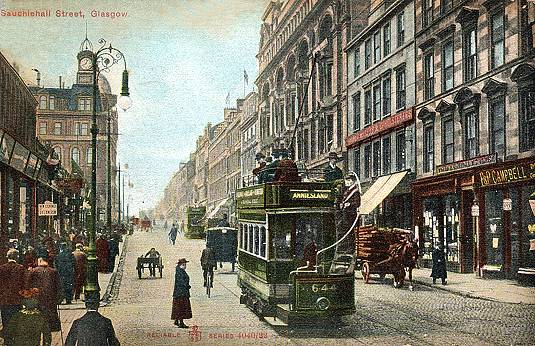

The city of Glasgow, in western Scotland, is divided by the River Clyde which brought prosperity during the 19th century. The city quickly became a major port and industrial centre for central Scotland with shipbuilding being the major industry at that time and well into the 20th century.
The first proposals for a Glasgow tramway came in 1860 from the well-known American pioneer George Francis Train who had opened his first British horse tramway in Birkenhead in August of that year. However, nothing came of these proposals.
It was not until 19 August 1872 that the first horse tramways opened, built by Glasgow Corporation but leased to the Glasgow Tramway and Omnibus Co. Ltd. Within a few years, there were over 230 trams and 25 miles of track, all laid to a gauge of 4ft. 73/4in. (1416mm), 3/4in (19mm) narrower than standard gauge. This allowed standard gauge railway wagons to run with their wheel flanges in the tram rail groove, a useful benefit for a heavily industrialised city especially around the Govan shipyards. In 1894, the corporation took over operation of the tramways and proceeded to modernise and extend the system. The first electric trams started on 13 October 1898. Ultimately, the Glasgow tramway had 135 miles of tracks, one of the most extensive in Britain.
Our postcard shows Glasgow Corporation electric car 644 in Sauchiehall Street, central Glasgow, westbound to Anniesland, most likely having started its journey in the south of the city. It is a 1901 or 1902 view published in the 'Reliable Series' by Edinburgh publisher William Ritchie & Sons. Electric trams started running in Sauchiehall Street in 1901 so the absence of any motor traffic is of no surprise. We see the conductor standing on the stairs and the top deck occupied by bowler-hatted gentlemen in this rear view of the tram. The precise location is by the entrance to Hope Street (just visible on the left), a little to the west of the Renfield Street junction.
The shop on the immediate left (on Hope Street corner) is Craske's Cloaks and opposite, on the right of the picture, are the premises of P & P Campbell of the Perth Dye Works that ran a chain of cleaners and dyers. In the window they have a special offer on carpets. Above the shop was the dentist Donald Cameron. In mid-distance on the left is the clock tower on Copland and Lye's department store and just beyond that can be seen the dome above Pettigrew and Stephens.
This postcard view had a long life over very many years and is the most common Glasgow tram postcard to find, appearing in a number of different forms well into the 1920s.
Tram 644 illustrated was one of over 220 in the series 440-664, built by the corporation c.1900 as an open-top, short-balcony car seating 25 downstairs and 30 upstairs, mounted on a Brill 21E truck with two 30hp Westinghouse 49B motors and BTH B18 controllers. Later, these became known as 'Standard round-dash Phase 1' cars. Over the years, these were top-covered and, by 1935, were totally enclosed. The coloured postcard shows the tram in a substantially dark green livery with a white or pale cream 'rocker' panel but these were not its true colours. The rocker panel was ivory, the dashes and truck a plum brown, the waist panel was cadmium orange and other body parts varnished teak. Before the introduction of route numbers in 1938, the modesty panels (those above the lower deck windows) were painted one of five colours to show which route the tram was operating on. Tram 644 was green.
Post-war, the corporation built 100 'Cunarder' bogie cars between 1948 and 1952, six 'Coronation' cars in 1954 and also purchased 25 quite modern cars from Liverpool in 1954. But in spite of this fleet modernisation, the tramway steadily dwindled to nothing when, on 1 September 1962, the last trams ran. It was the last of the 'classic' street tramways in Britain to close. Because of its relatively late demise, even after the Crich museum tramway had been founded, a number of Glasgow trams have survived as 'runners' in preservation.
There was a flirtation with trolleybuses from 1949 and a number of tram routes were replaced by them. However, they only lasted until 1967, by which time the motor bus had finally supplanted electric street traction in Glasgow.
![]() Go to Postcard Of The Month Index
Go to Postcard Of The Month Index